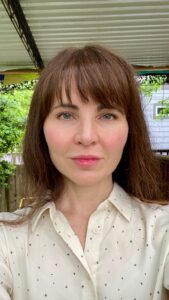Posted By: The American Journal of Human Genetics, AJHG
Each month, the editors of The American Journal of Human Genetics interview an author of a recently published paper. This month, we check in with Lisa (@lisa_bastarache) to discuss her recent paper “Characterizing trends in clinical genetic testing: A single-center analysis of EHR data from 1.8 million patients over two decades.”

AJHG: What motivated you to start working on this project?
LB: A few years ago, I had an experience that made me realize that clinical genetic testing in the electronic health record (EHR) represented an enormous and largely untapped resource that could help patients and drive science. During a weekly meeting of the Undiagnosed Disease Network (UDN), we were discussing a patient with autism and other symptoms. This patient had a de novo frameshift variant in the gene MSL2, which was a promising diagnostic candidate. But the gene wasn’t linked to any specific disease yet. The UDN team used MatchMaker exchange — a wonderful service that helps find patients with similar variants — but there were no matches.
So, we were at a dead end. I asked if the clinicians had seen any other patients with a similar variant. After all, they were doing a lot of clinical sequencing in their genetics clinic. They told me that there was no easy way to find out. I was shocked. How could this be?
I decided to run a simple string search for the gene name in our de-identified (EHR) database. Lo and behold, there were two patients with de novo variants in MSL2 who had been seen at Vanderbilt. The UDN clinical team reviewed these records and found strong phenotypic similarities. With additional evidence gathered by the UDN team, we were able to inform the patient and her family about the genetic cause of her condition. A few years later, the gene was officially added to the Online Mendelian Inheritance in Man (OMIM) Database.
The solution wasn’t glamorous or technically advanced, but it made a real difference in a patient’s life. The truth is, thousands of patients are being tested each year at our institutions, yet the data isn’t stored in a way that’s easily accessible to researchers or clinicians. And this isn’t just a problem at my institution—it’s widespread. That’s when I realized we needed to start a project to systematically curate genetic test results.
AJHG: What about the paper/project most excites you?
LB: I am super excited about the research that we can do with clinical genetic databases, which I think will open up an entirely new way of studying rare genetic diseases. Medical geneticists have built a remarkable knowledge base of the clinical manifestations of genetic diseases, but this information is typically presented from the specialist’s viewpoint. By linking genetic test results and diagnoses to the EHR, we can explore these conditions from a fresh perspective. I believe there is much to be discovered about early and subtle manifestations of these disorders, which can help patients.
Additionally, there’s a lot we still don’t understand about the operational side of genetic testing—how it’s used and how current practices can be improved for efficiency. Research in this area could inform how clinicians use genetic tests for diagnosing and managing rare conditions.
AJHG: Thinking about the bigger picture, what implications do you see from this work for the larger human genetics community?
LB: Clinical genetic databases are like a new type of biobank that is particularly well-suited to studying rare genetic conditions. Consider the incredible advances the field of genetics has achieved through population biobanks like the UK Biobank and All of Us in the study of complex disease and common variants. I think clinical genetic databases can be similarly transformative, if we are able to build more of these resources and develop methods to use them.
AJHG: What advice do you have for trainees/young scientists?
LB: I have two pieces of advice for young scientists. First, hone your skills and craft. Immerse yourself in your area of study and keep up the grind, week to week, year to year. It is through repetition that you will acquire the skills needed for research, and it will give you a deep understanding of a process that will allow you to think creatively.
Second, remain true to yourself. You and every other person in this world have your own perspective shaped by your life experiences. This uniqueness is a tremendous strength because it gives you a different perspective, which is the seed of creativity. Science thrives on creativity, so trust your instincts and tackle problems where your perspective allows you to see things differently than others.
AJHG: And for fun, tell us something about your life outside of the lab.
LB: I have simple tastes—I enjoy good conversation and taking long walks. So, if you see me at a conference or meeting and feel like going for a leisurely, aimless walk, just let me know.
Lisa Bastarache, MS is a Research Associate Professor at Vanderbilt University Medical Center at the Center for Precision Medicine.
